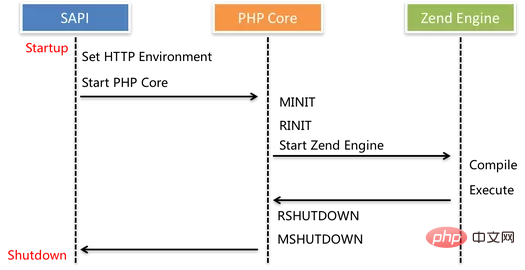Why run Laravel on Swoole? Because using Swoole can speed up Laravel applications. The following article will talk to you about how to use Laravel on Swoole. I hope it will be helpful to you!

#Swoole is a production-grade asynchronous programming framework developed for PHP. It is a purely C-developed extension that allows PHP developers to write high-performance, scalable concurrent TCP, UDP, Unix socket, HTTP, and WebSocket services in PHP without having to have too much non-blocking I/O programming. and low-level Linux kernel knowledge. You can think of Swoole as NodeJS, but with higher performance for PHP. [Recommended learning: swoole tutorial]
Why run Laravel on Swoole?
The following figure shows the life cycle of PHP. As you can see, every time you run a PHP script, PHP needs to initialize modules and start the Zend engine for your runtime environment. And compile PHP scripts into OpCodes for Zend engine execution.
However, such a life cycle needs to be executed every time a request is made. Because the environment created by a single request will be destroyed immediately after the request execution is completed.
In other words, in the traditional PHP life cycle, a lot of time is wasted creating and destroying resources for script execution. Imagine a framework like Laravel, how many Why run Laravel on Swoole?s need to be loaded in each request? At the same time, a lot of I/O operations are wasted

So if we use Swoole to build a Application-level Server, and all script Why run Laravel on Swoole?s can be saved in memory after being loaded once? This is why we need to try running Laravel on Swoole. Swoole can provide powerful performance while Laravel can provide elegant code structure usage. These two are really a perfect combination!
Installation
The following are the main features of swooletw/laravel-swoole:
- Run Laravel/Lumen application in Swoole
- Excellent performance improved to 30x
- Sandbox mode isolation application container
- Support running WebSocket server in Laravel application
- Support
Socket.ioProtocol - Support Swoole table cross-process sharing
Use Composer to install:
$ composer require swooletw/laravel-swoole
This package depends on At Swoole. Before using this package, make sure your machine has the correct Swoole installed. Use the following command to quickly install (linux):
pecl install swoole
After installing this extension, you need to edit php.ini and add extension=swoole.so.
php -i | grep php.ini # check the php.ini Why run Laravel on Swoole? location sudo echo "extension=swoole.so" >> php.ini # add the extension=swoole.so to the end of php.ini php -m | grep swoole # check if the swoole extension has been enabled
Visit the official website for more information.
Note: Swoole currently only supports Linux and OSX. Windows servers are not supported yet.
Then, add the service provider:
If you use Laravel, add the service provider in the config/app.php service provider array:
[
'providers' => [
SwooleTW\Http\LaravelServiceProvider::class,
],
] If you use Lumen, please add the following code to bootstrap/app.php:
$app->register(SwooleTW\Http\LumenServiceProvider::class);
This package supports the package auto-discovery mechanism. If you are running Laravel 5.5 or above, you can skip this step.
Get it up and running
Now, you can execute the following command to start the Swoole HTTP service.
$ php artisan swoole:http start
Then you can see the following information:
Starting swoole http server... Swoole http server started: <http://127.0.0.1:1215>
You can now enter the Laravel application by visiting http://127.0.0.1:1215.
Benchmark test
Using MacBook Air 13-inch (produced in 2015) and clean Lumen 5.5 project test:
Benchmark test tool: wrk
wrk -t4 -c100 http://your.app
Nginx based on FPM
Running 10s test @ http://lumen.app:9999
4 threads and 100 connections
Thread Stats Avg Stdev Max +/- Stdev
Latency 1.14s 191.03ms 1.40s 90.31%
Req/Sec 22.65 10.65 50.00 65.31%
815 requests in 10.07s, 223.65KB read
Requests/sec: 80.93
Transfer/sec: 22.21KBSwoole HTTP service
Running 10s test @ http://127.0.0.1:1215
4 threads and 100 connections
Thread Stats Avg Stdev Max +/- Stdev
Latency 11.58ms 4.74ms 68.73ms 81.63%
Req/Sec 2.19k 357.43 2.90k 69.50%
87879 requests in 10.08s, 15.67MB read
Requests/sec: 8717.00
Transfer/sec: 1.55MBMore Information
View the official package in Github Repo, and you can also refer to Official Documentation for more information.
English original address: https://laravel-news.com/laravel-swoole?
[Related recommendations: laravel video tutorial]
The above is the detailed content of Why run Laravel on Swoole?. For more information, please follow other related articles on the PHP Chinese website!

Hot AI Tools

Undress AI Tool
Undress images for free

Undresser.AI Undress
AI-powered app for creating realistic nude photos

AI Clothes Remover
Online AI tool for removing clothes from photos.

Clothoff.io
AI clothes remover

Video Face Swap
Swap faces in any video effortlessly with our completely free AI face swap tool!

Hot Article

Hot Tools

Notepad++7.3.1
Easy-to-use and free code editor

SublimeText3 Chinese version
Chinese version, very easy to use

Zend Studio 13.0.1
Powerful PHP integrated development environment

Dreamweaver CS6
Visual web development tools

SublimeText3 Mac version
God-level code editing software (SublimeText3)

Hot Topics
 Laravel Vue.js single page application (SPA) tutorial
May 15, 2025 pm 09:54 PM
Laravel Vue.js single page application (SPA) tutorial
May 15, 2025 pm 09:54 PM
Single-page applications (SPAs) can be built using Laravel and Vue.js. 1) Define API routing and controller in Laravel to process data logic. 2) Create a componentized front-end in Vue.js to realize user interface and data interaction. 3) Configure CORS and use axios for data interaction. 4) Use VueRouter to implement routing management and improve user experience.
 How to test Laravel API interface?
May 22, 2025 pm 09:45 PM
How to test Laravel API interface?
May 22, 2025 pm 09:45 PM
Efficient methods for testing Laravel API interfaces include: 1) using Laravel's own testing framework and third-party tools such as Postman or Insomnia; 2) writing unit tests, functional tests and integration tests; 3) emulating a real request environment and managing database status. Through these steps, the stability and functional integrity of the API can be ensured.
 How to customize Laravel's user authentication logic?
May 22, 2025 pm 09:36 PM
How to customize Laravel's user authentication logic?
May 22, 2025 pm 09:36 PM
Custom Laravel user authentication logic can be implemented through the following steps: 1. Add additional verification conditions when logging in, such as mailbox verification. 2. Create a custom Guard class and expand the authentication process. Custom authentication logic requires a deep understanding of Laravel's authentication system and pay attention to security, performance and maintenance.
 How to create Laravel package (Package) development?
May 29, 2025 pm 09:12 PM
How to create Laravel package (Package) development?
May 29, 2025 pm 09:12 PM
The steps to create a package in Laravel include: 1) Understanding the advantages of packages, such as modularity and reuse; 2) following Laravel naming and structural specifications; 3) creating a service provider using artisan command; 4) publishing configuration files correctly; 5) managing version control and publishing to Packagist; 6) performing rigorous testing; 7) writing detailed documentation; 8) ensuring compatibility with different Laravel versions.
 Laravel integration with social media login (OAuth)
May 22, 2025 pm 09:27 PM
Laravel integration with social media login (OAuth)
May 22, 2025 pm 09:27 PM
Integrating social media login in the Laravel framework can be achieved by using the LaravelSocialite package. 1. Install the Socialite package: use composerrequirelaravel/socialite. 2. Configure the service provider and alias: add relevant configuration in config/app.php. 3. Set API credentials: Configure social media API credentials in .env and config/services.php. 4. Write controller method: Add redirection and callback methods to handle social media login process. 5. Handle FAQs: Ensure user uniqueness, data synchronization, security and error handling. 6. Optimization practice:
 How to implement password reset function in Laravel?
May 22, 2025 pm 09:42 PM
How to implement password reset function in Laravel?
May 22, 2025 pm 09:42 PM
Implementing password reset function in Laravel requires the following steps: 1. Configure the email service and set relevant parameters in the .env file; 2. Define password reset routes in routes/web.php; 3. Customize email templates; 4. Pay attention to email sending problems and the validity period of tokens, and adjust the configuration if necessary; 5. Consider security to prevent brute-force attacks; 6. After the password reset is successful, force the user to log out of other devices.
 Common security threats and protection measures for Laravel applications
May 22, 2025 pm 09:33 PM
Common security threats and protection measures for Laravel applications
May 22, 2025 pm 09:33 PM
Common security threats in Laravel applications include SQL injection, cross-site scripting attacks (XSS), cross-site request forgery (CSRF), and file upload vulnerabilities. Protection measures include: 1. Use EloquentORM and QueryBuilder for parameterized queries to avoid SQL injection. 2. Verify and filter user input to ensure the security of output and prevent XSS attacks. 3. Set CSRF tokens in forms and AJAX requests to protect the application from CSRF attacks. 4. Strictly verify and process file uploads to ensure file security. 5. Regular code audits and security tests are carried out to discover and fix potential security vulnerabilities.
 What is Middleware in Laravel? How to use it?
May 29, 2025 pm 09:27 PM
What is Middleware in Laravel? How to use it?
May 29, 2025 pm 09:27 PM
Middleware is a filtering mechanism in Laravel that is used to intercept and process HTTP requests. Use steps: 1. Create middleware: Use the command "phpartisanmake:middlewareCheckRole". 2. Define processing logic: Write specific logic in the generated file. 3. Register middleware: Add middleware in Kernel.php. 4. Use middleware: Apply middleware in routing definition.






